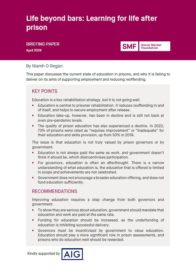Education is central to prisoner rehabilitation, but take-up of it has been in decline and is still not back at even pre-pandemic levels. This paper discusses the current state of education in prisons, and why it is failing to deliver on its aims of supporting employment and reducing reoffending.
KEY POINTS
Education is a key rehabilitation strategy, but it is not going well.
- Education is central to prisoner rehabilitation. It reduces reoffending in and of itself, and helps to secure employment after release.
- Education take-up, however, has been in decline and is still not back at even pre-pandemic levels.
- The quality of prison education has also experienced a decline. In 2023, 73% of prisons were rated as “requires improvement” or “inadequate” for their education and skills provision, up from 50% in 2019.
The issue is that education is not truly valued by prison governors or by government.
- Education is not always paid the same as work, and government doesn’t think it should be, which disincentivises participation.
- For governors, education is often an afterthought. There is a narrow understanding of what education is, the education that is offered is limited in scope and achievements are not celebrated.
- Government does not encourage a broader education offering, and does not fund education sufficiently.
RECOMMENDATIONS
Improving education requires a step change from both governors and government.
- To show they are serious about education, government should mandate that education and work are paid at the same rate.
- Funding for education should be increased, as the underfunding of education is inhibiting successful delivery.
- Governors must be incentivised by government to value education. Education should play a more significant role in prison assessments, and prisons who do education well should be rewarded.

DOWNLOAD THE BRIEFING: PDF
Kindly sponsored by

